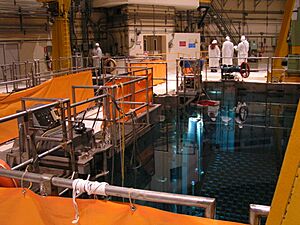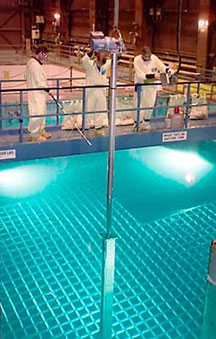Spent fuel pool facts for kids

A spent fuel pool is like a very deep swimming pool designed to safely store used fuel from a nuclear reactor. These pools are usually more than 12 meters (40 feet) deep. The used fuel, which is still very hot and radioactive, is placed in special racks at the bottom of the pool.
The water in the pool does two very important jobs. First, it cools down the hot fuel. Second, it acts as a shield to block the radiation, which keeps workers and the environment safe. The pools are located at the nuclear power plant site and are used to store the fuel for several years after it's removed from the reactor.
While only about 6 meters (20 feet) of water is needed to block the radiation, the extra depth provides an additional layer of safety. It also allows workers to move the fuel assemblies around underwater without needing extra shielding.
Contents
How Spent Fuel Pools Work
Nuclear reactors need to have their fuel changed regularly, about every 1 to 2 years. About one-third of the old, or "spent," fuel is taken out and replaced with fresh fuel. This spent fuel is still producing a lot of heat and radiation, so it must be handled very carefully.
Storing the Fuel Safely
The spent fuel is moved from the reactor to the pool using robotic systems. Once in the pool, the fuel bundles are placed into strong metal racks. These racks keep the fuel organized and safely separated from each other.
To make storage extra safe, these racks are often made with materials that absorb neutrons, like boron. This prevents any further nuclear reactions from happening. This state is called "subcritical," meaning the reaction has stopped.
Keeping the Water Cool and Clean
The water in the pool gets hot from the fuel. To keep it cool, pumps constantly circulate the water through heat exchangers, which are devices that remove heat. The pool's water temperature is normally kept below 50°C (120°F).
The water quality is also checked all the time. This is to make sure nothing is causing the fuel rods to break down. The air in the room is also monitored to prevent any buildup of gases.
Safety and Security
Spent fuel pools are designed with many safety features to protect against accidents.
What Happens if Cooling Stops?
The pools have backup cooling systems in case of an emergency. If the cooling systems were to stop working for a long time, the water could start to boil. This is a serious situation, so nuclear plants have multiple backup plans and power sources to make sure the cooling systems always have electricity.
Learning from Natural Disasters
In March 2011, a massive earthquake and tsunami hit Japan, causing the Fukushima nuclear disaster. Some of the buildings containing spent fuel pools were damaged. Experts studied this event very closely to learn how to make pools even safer and more resistant to extreme natural disasters.
Are the Pools Secure?
Nuclear power plants are among the most secure facilities in the world. They are protected by many layers of security to prevent anyone from causing harm to the plant or the spent fuel pools.
The Future of Spent Fuel
Spent fuel pools are a safe way to store used nuclear fuel for many years. However, they are not a permanent solution. After the fuel has cooled down in the pool for several years, it is often moved to a more permanent storage place.
One common method is dry cask storage. In this method, the cooled fuel is placed inside very strong and thick containers made of steel and concrete. These casks block radiation and can be stored safely for a very long time.
Scientists are also researching new ways to recycle spent fuel. Some new types of reactors might be able to use this old fuel to create more energy. This could help reduce the amount of nuclear waste that needs to be stored permanently.
See also
- Deep geological repository
- Dry cask storage
- Lists of nuclear disasters and radioactive incidents
- Nuclear fuel cycle
- Radioactive waste
- Spent nuclear fuel shipping cask
- Cherenkov radiation




